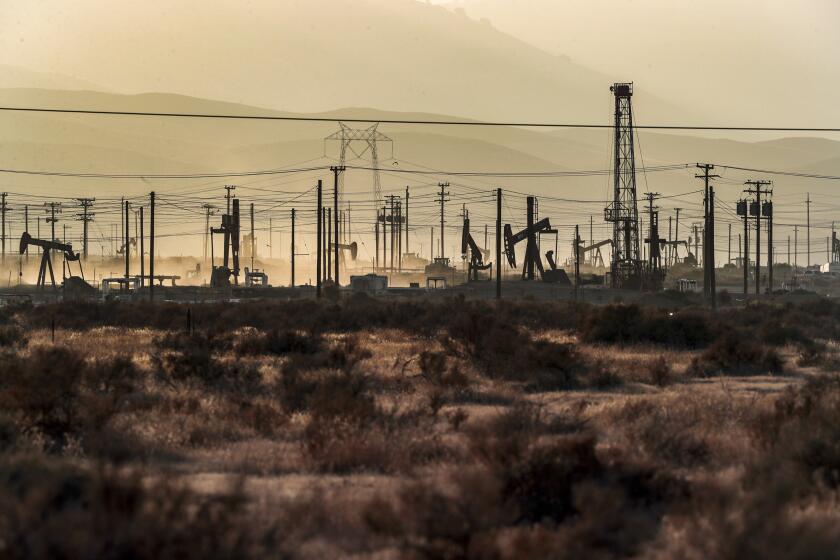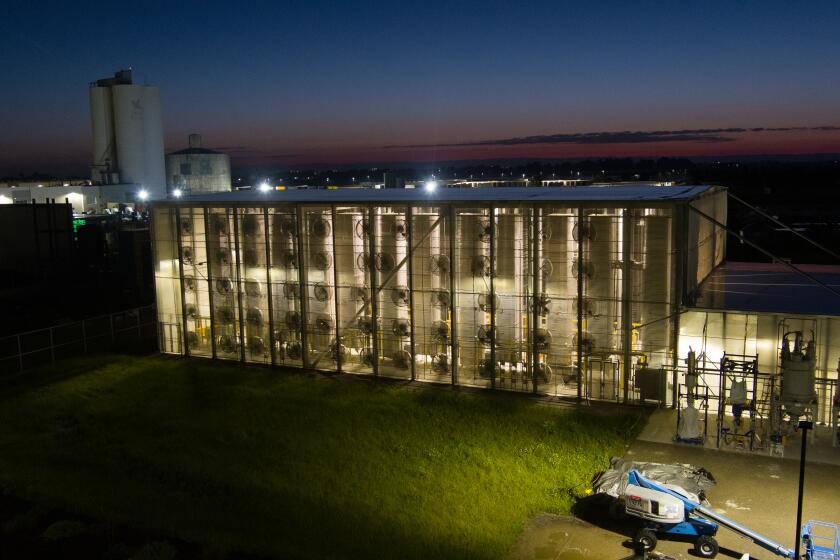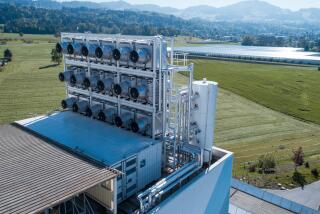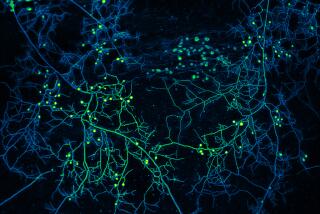
- Share via
A typical large tree can suck as much as 40 kilograms of carbon dioxide out of the air over the course of a year. Now scientists at UC Berkeley say they can do the same job with less than half a pound of a fluffy yellow powder.
The powder was designed to trap the greenhouse gas in its microscopic pores, then release it when it’s ready to be squirreled away someplace where it can’t contribute to global warming. In tests, the material was still in fine form after 100 such cycles, according to a study published Wednesday in the journal Nature.
“It performs beautifully,” said Omar Yaghi, a reticular chemist at UC Berkeley and the study’s senior author. “Based on the stability and the behavior of the material right now, we think it will go to thousands of cycles.”
Dubbed COF-999, the powder could be deployed in the kinds of large-scale direct air-capture plants that are starting to come online to reduce the amount of carbon in the atmosphere.
Kern County has signed off on an oil company’s plan to permanently store greenhouse gas emissions underground in a depleted oil field, marking California’s first foray into carbon storage and a potential new role for oil and gas companies.
Keeping the concentration of atmospheric carbon dioxide below 450 parts per million is necessary to limit global warming to 2 degrees Celsius above preindustrial levels and prevent some of the most dire consequences of climate change, scientists say. Measurements taken at the Mauna Loa Observatory in Hawaii indicate that CO2 levels are currently around 423 ppm.
“You have to take CO2 from the air — there’s no way around it,” said Yaghi, who is also chief scientist at Berkeley’s Bakar Institute of Digital Materials for the Planet. “Even if we stop emitting CO2, we still need to take it out of the air. We don’t have any other options.”
Klaus Lackner, founding director of the Center for Negative Carbon Emissions at Arizona State University, agreed that direct air capture will become an important tool for sequestering carbon and cooling the planet once important hurdles have been overcome. The advances in the new study may help, he said.
“They are opening a door into a new family of approaches,” said Lackner, who wasn’t involved in the research.
Giant sun shades, 40-foot-tall air filters, stratospheric sulfur injections: Here are some of the wild and wondrous ways we might save the planet.
When viewed under a scanning electron microscope, the powder resembles tiny basketballs with billions of holes, said study leader Zihui Zhou, a materials chemist who is working on his PhD at UC Berkeley.
The structures are held together by some of the strongest chemical bonds in nature, including the ones that turn carbon atoms into diamonds. Attached to the scaffolds are compounds called amines.
When air flows through the structures, most of its components pass by undisturbed. But the amines, which are basic, grab on to carbon dioxide, which is acidic.

Those CO2 molecules will stay put until scientists loosen them up by applying heat. Then they can vacuum them up for safekeeping, most likely by pumping them deep underground, Zhou said.
Once the carbon dioxide is removed from the powder, the entire process can begin again.
To test the carbon-clearing capabilities of COF-999, the researchers packed the powder into a stainless steel tube about the size of a straw and exposed it to outdoor Berkeley air for 20 days straight.
As it entered the tube, the Berkeley air contained CO2 in concentrations ranging from 410 ppm to 517 ppm. When it came out the other side, the scientists could not detect any carbon dioxide at all, Zhou said.
Multiple projects seeking to remove carbon dioxide from the air have been launched across Los Angeles County.
The powder has several advantages over other materials, according to its creators.
Its porous design increases its surface area, which means more places to hold on to CO2 molecules. As a result, it captures carbon dioxide at a rate that is “at least 10 times faster” than other materials used for direct air capture, Zhou said.
Team members have continued to make improvements, and they’re on track to double its capacity in the next year, Yaghi added.
Another plus is that COF-999 will loosen its hold on the CO2 when it’s heated to about 140 degrees Fahrenheit. Comparable materials must be heated to 250 degrees F to extract carbon, Zhou said.
The powder is more durable as well. Zhou said the team has tested a newer version that worked for 300 cycles before the experiment came to an end.
Lackner said that was a promising sign.
“Getting 100 cycles out and not seeing any deterioration suggests you can get thousands of cycles,” he said. “Whether you can get hundreds of thousands of cycles, we don’t know.”
To deploy it on an industrial scale will require designing some kind of large metal box that air can pass through without blowing all the powder away, Zhou said. Those boxes would need to be clustered together in quantities that evoke a modern-day chemical or petroleum plant.

Yaghi said a version of COF-999 could be ready for direct air capture plants within two years. He couldn’t estimate what it would cost to produce in bulk, but he said it doesn’t require any expensive or exotic materials.
Yaghi founded a company, Irvine-based Atoco, to commercialize his research on carbon capture and other technologies. Atoco helped fund the new study. (Other financial backers include the Bakar Institute and the King Abdulaziz City for Science and Technology.)
In addition, UC Berkeley has filed a patent application for COF-999, which names Yaghi and Zhou as inventors.
Lackner said the entire direct air capture process will have to become “10 times cheaper than it is now” before it can make a real dent in the hundreds of billions of tons of carbon dioxide that scientists would love to scrub from the atmosphere.
A material that’s more efficient at collecting CO2 would help, but Lackner said he spends more time fretting about problems like the heat that’s lost when temperatures are raised to harvest the carbon so it can be injected underground.
“There are a thousand things that feed into this,” he said.
Toward a more sustainable California
Get Boiling Point, our newsletter exploring climate change, energy and the environment, and become part of the conversation — and the solution.
You may occasionally receive promotional content from the Los Angeles Times.










